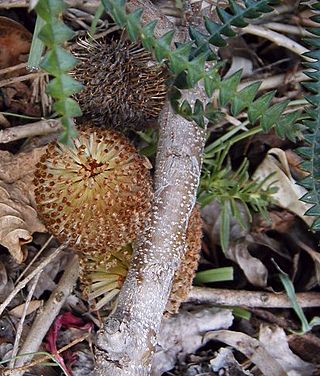
As with other flowering plants, the taxonomy of Banksia has traditionally been based on anatomical and morphological properties of the Banksia flower, fruiting structure and seed, along with secondary characteristics such as leaf structure and growth habit. Increasingly, molecular evidence from DNA is providing important new insights into relationships within the genus and between this and other genera in the Proteaceae.

Banksia caleyi, commonly known as Caley's banksia or red lantern banksia, is a species of woody shrub of the family Proteaceae native to Western Australia. It generally grows as a dense shrub up to 2 m (7 ft) tall, has serrated leaves and red, pendent (hanging) inflorescences which are generally hidden in the foliage. First described by Scottish naturalist Robert Brown in 1830, Banksia caleyi was named in honour of the English botanist George Caley. No subspecies are recognised. It is one of three or four related species with hanging inflorescences, which is an unusual feature within the genus.

Banksia praemorsa, commonly known as the cut-leaf banksia, is a species of shrub or tree in the plant genus Banksia. It occurs in a few isolated populations on the south coast of Western Australia between Albany and Cape Riche.

Banksia ser. Dryandroideae is a taxonomic series in the plant genus Banksia. First published by Carl Meissner in 1856, the name has had two circumscriptions. As presently circumscribed it is monotypic, containing only B. dryandroides.

Banksia ser. Salicinae is a valid botanic name for a series of Banksia. First published by Carl Meissner in 1856, the name has had three circumscriptions.

Banksia ser. Cyrtostylis is a taxonomic series within the plant genus Banksia. First published at sectional rank by George Bentham in 1870, it was demoted to a series by Alex George in 1981. The name has had three circumscriptions.
Banksieaephyllum is a plant genus that encompasses organically preserved fossil leaves that can be attributed to the Proteaceae tribe Banksieae, but cannot be attributed to a genus.
Banksia ionthocarpa is a species of shrub that is endemic to Western Australia. It has short, hairy, prostrate stems, pinnatifid leaves, pinkish purple to orange flower in heads of between forty and sixty at the base of leaves, and egg-shaped follicles with a distinctive tuft of hairs on the end.

Banksia subulata, commonly known as the awled honeypot, is a species of bushy, prostrate shrub that is endemic to the southwest of Western Australia. It has long linear leaves with the edges turned under, yellowish green flowers in heads of about sixty and more or less spherical follicles.

Banksia subg. Spathulatae is a valid botanic name for a subgenus of Banksia. It was published in 2007 by Austin Mast and Kevin Thiele, and defined as containing all those Banksia species having spathulate (spoon-shaped) cotyledons. The name was published to accommodate forthcoming changes to the taxonomic arrangement of Banksia, based on the DNA sequence analyses of Austin Mast and others, which suggested a phylogeny for Banksia very greatly different from the accepted taxonomic arrangement. They found Banksia to be paraphyletic with respect to Dryandra, and that these two genera were best split into two clades, one with beaked follicles and non-spathulate cotyledons, the other with unbeaked follicles and spathulate cotyledons. Initially this clade was informally named "/Cryptostomata", in reference to the stomates, which are sunken with constricted entrances. Accordingly, in 2007 Mast and Thiele initiated a rearrangement by transferring Dryandra to Banksia, and publishing B. subg. Spathulatae for the species having spathulate cotyledons. The type species of Spathulatae was given as B. integrifolia, but no further details have been given. Mast and Thiele have foreshadowed publishing a full arrangement once DNA sampling of Dryandra is complete.

Banksia subser. Longistyles is a valid botanic name for a subseries of Banksia. It was published by Kevin Thiele in 1996, but discarded by Alex George in 1999.

Banksia subser. Leptophyllae is a valid botanic name for a subseries of Banksia. It was published by Kevin Thiele in 1996, but discarded by Alex George in 1999.

Banksia subser. Sphaerocarpae is a valid botanic name for a subseries of Banksia. It was published by Kevin Thiele in 1996, but discarded by Alex George in 1999.

Banksia ser. Ochraceae is a valid botanic name for a taxonomic series within the plant genus Banksia. It was published by Kevin Thiele in 1996, but discarded by Alex George in 1999.

Banksia subser. Cratistylis is a valid botanic name for a subseries of Banksia. It was first published by Kevin Thiele in 1996 but discarded by Alex George in 1999.
Dryandra ser. Niveae is an obsolete series within the former genus Dryandra. It was first published by George Bentham in 1870, and was given a new circumscription by Alex George in 1996, but was ultimately discarded in 2007 when Austin Mast and Kevin Thiele sunk Dryandra into Banksia.

Dryandra ser. Ilicinae is an obsolete series within the former genus Dryandra. It was first published by Carl Meissner in 1856, but was discarded by George Bentham in 1870. It was reinstated with a new circumscription by Alex George in 1996, but was ultimately discarded again in 2007 when Austin Mast and Kevin Thiele sunk Dryandra into Banksia.
Dryandra ser. Capitellatae is an obsolete series within the former genus Dryandra. It was published by Alex George in 1996, but discarded in 2007 when Austin Mast and Kevin Thiele sank Dryandra into Banksia.
Banksieaeformis is a genus that encompasses plant species only known from fossil leaves that can be attributed to the Proteaceae tribe Banksieae, but cannot be attributed to an extant (living) genus. Unlike those classified in the related genus Banksieaephyllum, the leaves do not have their cuticular architecture preserved. The genus was defined by botanists Bob Hill and David Christophel in 1988 to distinguish banksia-like leaves that had been organically preserved from those that had not.

Suzanne Lawless Duigan was an Australian paleobotanist who specialised in fossil pollen (palynology). She collaborated with fellow botanist Isabel Cookson extensively on Paleogene brown coal deposits in Victoria. She pioneered studies in south east Australian coal measures as she considered micro- and macrofossils of the region in terms of their relationships to living plant species and families and their ecologies.













